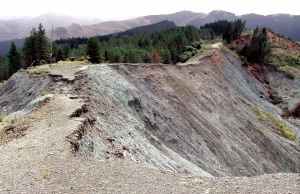Terrestrial WG 2009
CSDMS Terrestrial Working Group meeting, February 2-3, 2009

| Date: February 2-3, 2009 |
| Location: University of Colorado at Boulder (CO), USA |
| Host: CSDMS |
Introduction
The Terrestrial Working Group deals with weathering, hillslope, fluvial, glacial, aeolian, lacustrial challenges.
Participants
Registration is now closed.
Circulars and Program
The agenda for this meeting of the Terrestrial Working Group is two-fold. The first aim is to bring the working group up to speed on the progress that the I.F. team has made in developing methods and protocols for coupling modules, as well as to provide an overview of how to modify your own code so that it can be integrated into the CSDMS framework. The second aim is to make progress on three fronts:
- completing the process of “domain and model scoping” that we began at last year’s meeting, possibly leading to a review paper;
- identifying, developing, adding, and linking model components (including outlining methods for handling issues such as moving boundaries); and
- identifying existing data sets, and criteria for future data sets, that can be used for testing models and providing proof-of-concept applications.
The Terrestrial Working Group will meet for 2 days.
Agenda
Second Meeting of the CSDMS Terrestrial Working Group
Goals:
- Update the Terrestrial Working Group on current status of CSDMS activities
- Provide basic information on how to use CSDMS tools
- Discuss and develop recommendations on current state of the art (basic knowledge, existing computer models, knowledge/model gaps), essential components of a first-generation model, and key research needs.
- Discuss and develop recommendations on modeling issues and potential strategies, including topics such as handling moving boundaries and developing generic data structures for topography, soil, stratigraphy, etc.
- Discuss and develop recommendations on criteria for proof-of-concept tests and types of tests needed; identify and begin to characterize potential study sites and databases.
Expected Outcome:
- Participants will become familiar with CSDMS tools and concepts, such as CCA, OpenMI, basic steps in adapting models to the framework, and use of the CSMDS Wiki pages.
- Meeting report to CSDMS Executive and Steering Committees and other working and focus groups.
- First steps toward outlining and drafting three potentially publishable white papers (tentatively covering Scoping, Modeling, and Applications, respectively).
Format: The format will consist of a mix of presentations, demonstrations and hands-on exercises, breakout discussion groups, and writing sessions. Most time will be devoted to breakout-group and whole-group discussions.
Agenda:
Talks
| Presenter | Title |
|---|---|
| Ames, Daniel | MapWindow GIS |
| Anderson, Suzanne | Boulder Creek Critical Zone Observatory |
| Di Achille, Gaetano | Modeling ideas - erosion, sediment transport (MARSSIM, GOLEM, CHILD?) and deposition (SEDFLUX?) on Mars |
| Galewsky, Joe | Modeling landscape evolution |
| Howard, Alan | The Marssim model |
| Hutton, Eric | How to configure a model to operate as a component |
| Istanbulluoglu, Erkan | A Bucket-type Ecohydrology model: Water Balance |
| Jagers, Bert | Modeling activity by Deltares |
| Lancaster, Stephen | Debris Flows and Sediment in Steep Little Valleys |
| Leclair, Suzanne | Modeling short-term hydrosedimentary processes and the preservation of river dune deposits |
| Peckham, Scott | Overview and demonstration of the CSDMS (part 1) |
| Pelletier, Jon | Challenge: To find data-rich pilot projects that showcase CSDMS capabilities at short and long time scales. |
| Syvitski, James | CSDMS overview |
| Tucker, Greg | Charge to Working Groups |
| Tucker, Greg | Overview meeting |
WG Reports
| Presented by | Title | Download |
|---|---|---|
| WG report I | Scoping & Knowledge Gaps | ppt | pdf |
| WG report II | Modeling | ppt | pdf |
| WG report III | Applications | doc | pdf |
Meeting report
Feb. 2009: Recommendations for Modeling Land-Surface Processes, Terrestrial working group meeting report.
